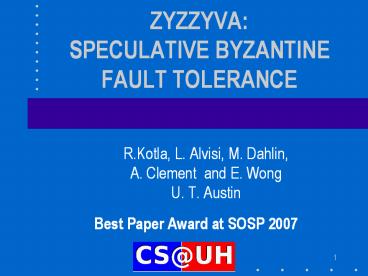ZYZZYVA: SPECULATIVE BYZANTINE FAULT TOLERANCE - PowerPoint PPT Presentation
Title:
ZYZZYVA: SPECULATIVE BYZANTINE FAULT TOLERANCE
Description:
Zyzzyva-5 is a special version of Zyzziva requiring more replicas but having a ... Observe that Zyzzyva is optimized for the most frequent case but provides the ... – PowerPoint PPT presentation
Number of Views:335
Avg rating:3.0/5.0
Title: ZYZZYVA: SPECULATIVE BYZANTINE FAULT TOLERANCE
1
ZYZZYVASPECULATIVE BYZANTINEFAULT TOLERANCE
- R.Kotla, L. Alvisi, M. Dahlin, A. Clement and
E. WongU. T. Austin
Best Paper Award at SOSP 2007
2
Motivation
- Why implement Byzantine Fault-Tolerant
replication? - Increasing value of data and decreasing cost of
hardware - More non-stop-fail behaviors than believed
- BFT is becoming cheaper
- Cost of 3-way non-BFT replication close to cost
of BFT replication
3
Zyzzyva (I)
- Uses speculation to reduce the cost of BFT
replication - Primary replica proposes order of client requests
to all secondary replicas (standard) - Secondary replicas speculatively execute the
request without going through an agreement
protocol to validate that order (new idea)
4
Zyzzyva (II)
- As a result
- States of correct replicas may diverge
- Replicas may send diverging replies to client
- Zyzzyvas solution
- Clients detect inconsistencies
- Help convergence of correct replicas to a single
total ordering of requests - Reject inconsistent replies
5
How?
- Clients observe a replicated state machine
- Replies contain enough information to let clients
ascertain if the replies and the history are
stable and guaranteed to be eventually committed - Replicas have checkpoints
6
Byzantine agreement (I)
- No solution for less than four entities
7
Byzantine agreement (II)
- To achieve agreement in the presence of f failed
nodes (traitors) we need - 3f 1 entities
8
Practical BFT (I)
- Practical Byzantine Fault-Tolerant protocol
(PBFT) Castro and Liskov 1999
9
Practical BFT (II)
Replicas decide on correct ordering
10
Practical BFT (III)
- Client sends signed request to primary replica
- Primary assigns a sequence number to the request
and sends to all other replicas aPRE-PREPARE
message - Secondary replicas validate the message and send
a PREPARE message to all replicas - Replicas that can collect 2f PREPARE messages
send a COMMIT message to all replicas - Replicas that can collect 2f 1 COMMIT message
send a REPLY to the client
11
A shortened version
Faster agreement is achieved thanks toa more
complex view change protocol
12
The explanation (I)
- "No replicated service that uses the traditional
view change protocol can be live without an
agreement protocol that includes both the prepare
and commit full exchanges" - "The traditional view change protocol lets
correct replicas commit to a view change and
become silent in a view without any guarantee
that their action will lead to the view change."
13
The explanation (II)
- Zyzzyva
- Adds an extra phase to its view change protocol
- Guarantees that a correct replica will not
abandon a view unless every other correct
replica does it
14
Zyzzyva Agreement (I)
- Common case no faulty replicas
15
Explanations
- Secondary replicas assume that
- Primary replica gave the right ordering
- All secondary replicas will participate in
transaction - Initiate speculative execution
- Client receives 3f 1 mutually consistent
responses
16
Zyzzyva Agreement (II)
- With a faulty replica
17
Explanations (I)
- Client receives 3f mutually consistent responses
- Gathers at least 2f 1 mutually consistent
responses - Distributes a commit certificate to the replicas
- Once at least 2f 1 replicas acknowledge
receiving a commit certificate, the client
considers the request completed
18
Explanations (II)
- If enough secondary replicas suspect that the
primary replica is faulty, a view change is
initiated and a new primary elected
19
Comparison with traditional solutions
20
State maintained at each replica
21
Explanations (I)
- Each replica maintains
- A history of the requests it has executed
- A copy of the max commit certificate it has
received - Let it distinguish between committed history and
speculative history
22
Explanations (II)
- Each replica constructs a checkpoint every
CP_INTERVAL requests - It maintains one stable checkpoint with a
corresponding stable application state snapshot - It might also have up to one speculative
checkpoint with its corresponding speculative
application state snapshot
23
Explanations (III)
- Checkpoints and application state become
committed through a process similar to that of
earlier BFT agreement protocols - Replicas send signed checkpoint messages to all
replicas when they generate a tentative
checkpoint - Commit checkpoint after they collect f 1
signed matching checkpoint messages
24
View change sub-protocol (I)
25
Explanations
- Two-phase protocol
- Elects a new primary
- Guarantees that it will not introduce any changes
in a history that has already completed at a
correct client
26
Performance throughput
27
Comments
- Zyzzyva-5 is a special version of Zyzziva
requiring more replicas but having a lower
overhead
28
Performance latency
29
Scalability peak throughputs
30
CONCLUSIONS
- Systematically exploiting speculative execution
results in a protocol much faster than
conventional BFT agreement protocols.
- Observe that Zyzzyva is optimized for the most
frequent case but provides the correct result in
all cases - A good rule to follow































